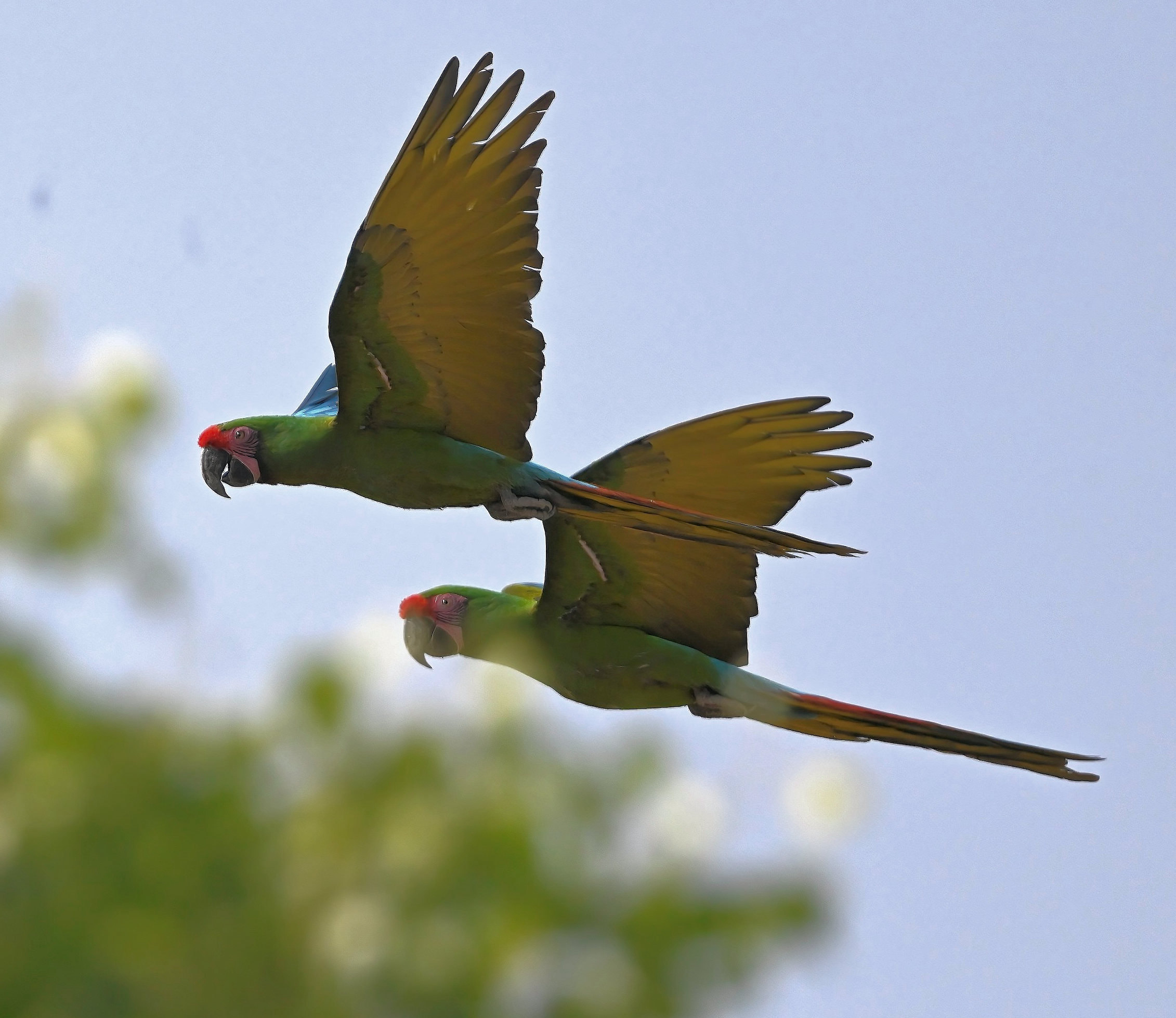
A pair of Military Macaws photographed in the state of Jalisco, Mexico by Al Konings.

Photo 2 – A pair of Military Macaws was documented at Big Bend National Park last week, establishing a First North American Record and first Texas State Record (photo by Kim Morse).
|
Last Tuesday, April 22nd, 2 Military Macaws were photographed at Rio Grande Village in Big Bend National Park in west Texas, which could be the first confirmed record of the species in the United States! The documented sighting is reported and explained in an impressive manner in an American Birding Association article published this week, authored by Tom Ford-Hutchinson and entitled “Military Macaws in Texas’s Big Bend National Park.” Of course, the first question that arises is: Are these wild birds that have moved farther north than any other Military Macaws, or are they birds that escaped from an aviary, released by pet owners, or involved in illegal pet trade in some way?
First, how close is the nearest wild population of Military Macaws to Big Bend National Park? Tom Ford-Hutchinson provided detailed information on that subject, writing that one of the northernmost clusters of Military Macaw populations is found in the Sierra Madre Oriental Mountains in Tamaulipas, Mexico – roughly 210 miles from Big Bend. Included in that cluster is the La Gloria–Jaumave population, which numbered about 473 Military Macaws prior to a published report in 2021, making it one of the largest groups in northeast Mexico.
Ford-Hutchinson continues to describe that in that area the macaws rely on forested montane ravines and cliffs for nesting, and the region is part of a pine-oak woodland corridor that extends northwest along the Sierra Madre Oriental Mountains into the state of Coahuila. While the habitat becomes increasingly fragmented and less suitable for Military Macaws farther north, larger areas of forest exist at higher elevations, including in the Maderas del Carmen Flora and Fauna Protection Area, located just 20 miles from the Texas sighting. Ford-Hutchinson adds that Military Macaws typically travel up to 15 miles daily to search for food, but when resources are scarce, they may undertake longer journeys exceeding 31 miles one-way, as described in a 2023 publication about the species.
With that information in mind, it is relatively easy to appreciate that the 2 Military Macaws observed and photographed in Big Bend National Park last week could be legitimate naturally occurring birds searching for food and other resources.
Always Some Question of Authenticity
With the above information in mind, this sighting was not the first report of Military Macaws north of the Mexican border. As Tom points out, on August 22, 1992, the storm remnants of Hurricane Lester moved northeast through Arizona after crossing the state of Sonora, Mexico. After the storm passed, birders found a group of 7 Military Macaws in southeast Arizona, near the border with Mexico at the Patagonia–Sonoita Creek Preserve. It is difficult to ascertain if these individuals escaped from a storm-damaged aviary in Mexico, or were displaced from their native range, which extends to 175 miles south of the Preserve. Nonetheless, that sighting remains “unconfirmed.”
This week’s Big Bend sighting would mark the first confirmed record of Military Macaws in the United Stated, and the birds appear to show physical characteristics consistent with wild-living birds as explained by Ford-Hutchinson. He also notes that the location of the sighting along the axis of the Sierra Madre Oriental, combined with continuing drought conditions in that area of Mexico, could explain their appearance just across the border in west Texas.
Of course, there will be reviews by the Texas Bird Records Committee and the American Birding Association Checklist Committee, and the Military Macaw will become species number 672 found withing the boundaries of the state of Texas. In this case, it genuinely looks like these are wild Military Macaws documented by an enthusiastic birder and reported on eBird with a list of other birds observed at Big Bend. Really, it’s all about the birds, and seeing these fantastic parrots in the wild within the borders of the United States and Texas must have been quite an experience!
What a thrill for anyone who has the chance to witness these remarkable birds and to photograph them for others to see! It must have been a remarkable jolt of excitement to see the Military Macaws in flight, in the United States, and to take documentary photographs to share with all. Congratulations to Kim, Greg, and others who had the thrilling opportunity to see these grand parrots, and we hope this species graces the United States again and again!
You are encouraged to refer to Tom Ford-Hutchinson’s article, published last Friday on the ABA website at Military Macaws in Texas’s Big Bend National Park - American Birding Association (aba.org)